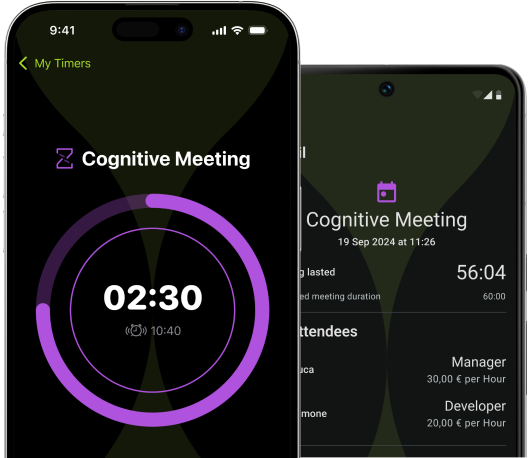Business Meetings are an essential tool in the corporate world: they allow the sharing of information, the making of decisions, and the coordination of activities among all of the company members. However, very often these are ineffective, turning into a waste of time and resources.
Every job meeting carries hidden costs, not only in terms of economics but also in time and productivity. Poorly organized business meetings can slow down projects, demotivate employees, and hinder efficiency. Understanding the true cost of each job meeting is therefore the first step in improving corporate culture and return on investment (ROI).
In this article we will explore the real cost of meetings and propose strategies to reduce it and optimize ROI accordingly.
The Real Cost of Meetings
Direct Economic Cost
Calculating the direct cost of a job meeting is essential to understanding how much lost time affects the budget, and doing so is actually very simple:
Number of participants × hourly wage × meeting duration.
For example, a one-hour job meeting with 10 participants earning 20 euros per hour costs the company a total of 200 euros. The costs become significant when multiplied by dozens of weekly business meetings.
Opportunity Cost
For this reason, every job meeting entails an opportunity cost: what actions could the participants have taken during that time? More focus on strategic activities, project development, or closing sales could generate a higher ROI than the job meeting itself.
Psychological and Cultural Cost
Another aspect, which is often underestimated by companies, is the psychological cost. Ineffective business meetings can demotivate employees and decrease engagement, while excessive meetings undermine confidence in decision-making autonomy and slow down operational processes. These mismanaged situations can cause harm to corporate culture, leading to various inefficiencies and loss of talent.
Practical Approaches to Reducing Costs
Assessing the necessity of the business meetings
Before arranging any job meeting, it is important to ask, “Is this really necessary?” Often, email or shared reports are quicker and cheaper alternatives. By using work organization tools like Slack or Trello, team members can access and communicate through private or shared individual chats, reducing the need to attend traditional business meetings and optimizing collaboration.
Minimizing the duration and number of participants
The more focused a job meeting is, the more effective! Lengthening the time tends to be ineffective, as the attention span is bound to decrease.
In this regard, one of the best ways to stay on top of things is to have a quick stand-up meeting every day. It’s a shorter type of job meeting (no more than 15 minutes) where everyone remains standing and meets at the same time and place to share updates on work progress and address any problems.
It’s also a good practice to invite only those who are essential. Having fewer participants means faster conversations and decisions, as well as less time wasted.
Effective preparation
A well-prepared job meeting is also a cheaper meeting! Establish an agenda, make sure everyone knows what the goal is, and send it out in advance. Assign specific roles: there should always be a moderator to keep the focus, a timekeeper, and a person in charge to note decisions.
Make Use of the Technology
Technology is a great ally in cutting costs! Video conferences on Zoom, Skype or Google Meet allows you to get rid of any travel costs – if there are any – while smart calendars like Google Calendar prevent your business meetings from overlapping. Advanced work tools such as Notion, Asana, and the aforementioned Slack and Trello, help companies to share information more easily.
A must-have are those tools that allow you to measure the time spent on the job meeting and calculate its total cost in relation to the number of participants and their roles. In this regard, if you’re looking for a solution, our Meeting Timer (inserire Link) application can do the trick! Download it via App store or Google Play Store.
Measure and Monitor
Analyzing closed business meetings should be an essential practice in all companies to improve meeting management and avoid recurring errors. Make sure you have a structured evaluation process with some targeted questions, such as “Were the objectives clear? Were any decisions made?” Asking “Were the discussions constructive?” Offers you a chance to give useful feedback and identify what’s working well and what could be improved.
Repeating this practice after each job meeting and saving responses will help you build a record of meeting effectiveness over time, providing a solid foundation for making continuous improvements. This approach promotes not only greater productivity, but also a more agile and goal-focused organization.
You can also use specific metrics to evaluate the effectiveness of your business meetings. For instance, you could look at how much time is spent versus how many decisions are made, or the ROI of strategy meetings. Keeping an eye on the results helps you spot where things could be done better and make improvements.
How to improve the ROI of Your Business Meetings
As explained so far, business meetings can be a powerful strategic tool, but only if they are well managed. An effective meeting is not just a waste of time and resources, it produces measurable and tangible value for the company. Here are some top tips for getting the most out of business meetings and maximizing the ROI:
Clear, Measurable Goals
It’s important to start every job meeting with a clear objective and defined expected outcomes. With a clear goal, you can steer the discussion and also assess whether the job meeting was a success. For instance:
- Instead of “discuss the marketing plan,” make sure you actually “approve key strategies for the new product launch.”
- Instead of “take stock of the project,” establish “identify priorities for the coming week.”
Communicating these goals clearly and in advance allows participants to prepare better and bring more focused and productive contributions. In addition, a clear goal will allow you to maintain focus during the job meeting, avoiding distraction or unnecessary detours.
Finally, measurable goals make it easier to assess ROI. If the job meeting has achieved its purpose effectively and on time, the return on investment will be positive.
Structured Follow-ups
A well-organized follow-up is key to turning decisions into concrete actions. At the end of the job meeting, promptly share a summary document that includes:
- Decisions made: A clear list of what has been agreed.
- Actions to be taken: Indicate who is responsible for each action and their deadlines.
- Deadlines: Set realistic dates for completing actions.
This approach reduces the risk of important decisions being forgotten or postponed. In addition, follow-up helps to maintain individual and collective accountability, ensuring that the time and resources invested in the job meeting produce concrete results.
To facilitate this practice, you can use digital tools mentioned earlier in this article, such as Trello, Slack or Asana, which allow you to assign tasks and monitor progress.
Creating an Efficiency-Driven Culture
Improving the ROI of meetings requires a cultural change. This means driving efficiency not just in individual business meetings, but across the organization. There are a number of initiatives that organizations can take to achieve this:
- Targeted training: Offer workshops on how to plan and run effective business meetings. Teach employees and managers how to set clear goals, meet deadlines and maintain focus.
- Reward efficiency: Recognize and reward virtuous behavior, such as reducing the number of unnecessary meetings or keeping business meetings short and productive.
- Encourage greater use of technology: Tools such as shared calendars, collaboration platforms and time management software can reduce the need for business meetings and improve their impact.
An efficiency-driven culture not only improves the ROI of meetings, but also helps to create a more agile and results-oriented work environment.
With these approaches, every job meeting can be transformed from a simple time for discussion to a strategic lever for business success. The time invested becomes a tangible value and the ROI of business meetings is increased.

Tools and Resources to Reduce the Cost of Meetings
Technology offers a wide range of tools to optimize business meetings. Here is a brief summary of some of the tools mentioned before and others:
Time-Management
To plan, monitor and optimize the use of time during business meetings, you can use our Meeting Timer app (inserire Link), available free to download on the App Store and Google Play Store. Meeting Timer is the ideal tool for keeping track of the duration of your business meetingsand calculating their cost, taking into account both the number of participants and the position each person holds.
Other time-management tools:
- Trello: Task management and visual agenda with bulletin boards.
- Asana: Manage projects and tasks with clear deadlines.
- Notion: Versatile platform for notes, schedules and databases.
- Clockify: Track time spent in meetings or projects.
- Toggl Track: Analyze and track of time spent on different tasks.
Job Meeting Planning
Set the job meeting times and dates to avoid clashes:
- Google Calendar: Intuitive scheduling and synchronization with other tools.
- Calendly: Automatically schedule meetings based on availability.
- Doodle: Tool to find the best availability of participants.
Job Meeting Analysis
Evaluate the effectiveness of business meetings and monitor ROI:
- Clockwise: Analysis of time spent in meetings versus productive work.
- Fellow: Gather feedback and evaluate meetings with structured reports.
- MeetingPulse: Interactive analysis with surveys and engagement tools.
- Less Meeting: Track and analyze meeting performance.
Collaboration During Business Meetings
Share documents, ideas and updates in real time:
- Slack: Instant collaboration with chat and file sharing.
- Miro: Virtual whiteboards for brainstorming and visual idea sharing.
- Microsoft Whiteboard: Visual drawing and collaboration tool.
- Dropbox Paper: Collaborative documents for taking notes and organizing ideas.
- Google Workspace: Collaborative documents, spreadsheets and presentations.
Preparation and Follow-up
Organize and document content before and after the job meeting:
- Evernote: Create structured and organized notes.
- Notion: Versatile tool for collecting agendas and assigning post-meeting tasks.
- Fellow: Manage notes and assign post-meeting tasks.
Brainstorming and Decision-Making
To facilitate idea generation and decision making:
Miro: Digital whiteboard for visualising ideas and concepts.
Stormboard: Brainstorm with visual collaboration tools.
Poll Everywhere: Real-time polling and voting for rapid decision making.
Video Conferencing
These tools are ideal for organizing remote business meetings:
Used strategically, these tools can improve the efficiency of your business meetings, reduce wasted time and deliver tangible results. They help organize, monitor and analyze the effectiveness of meetings, reducing waste and improving ROI.
In summary, business meetings have a hidden cost that can have a significant impact on corporate budgets and productivity. Calculating the true cost of meetings and implementing strategies to reduce it is critical.
Try to calculate the cost of your next job meeting and choose at least one of the suggested strategies to optimize it. The ROI of your business meetings will benefit greatly!




